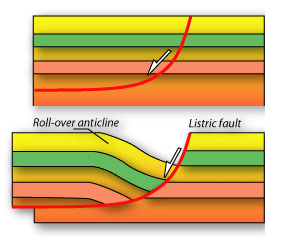 The second main type of faults found in extensional regimes, listric faults can be defined as curved normal faults in which the fault surface in concave upwards; its dip decreases with depth. These faults also occur in extension zones where there is a main detachment fracture following a curved path rather than a planar path. Hanging wall blocks may either rotate and slide along the fault plane (eg slumps), or they may pull away from the main fault, slipping instead only along the low dipping part of the fault. Roll-over anticlines will often form between bedding planes and the main fault plane as a result of the flexing between the two.
The second main type of faults found in extensional regimes, listric faults can be defined as curved normal faults in which the fault surface in concave upwards; its dip decreases with depth. These faults also occur in extension zones where there is a main detachment fracture following a curved path rather than a planar path. Hanging wall blocks may either rotate and slide along the fault plane (eg slumps), or they may pull away from the main fault, slipping instead only along the low dipping part of the fault. Roll-over anticlines will often form between bedding planes and the main fault plane as a result of the flexing between the two.
Listric Fault
The second main type of faults found in extensional regimes, listric faults can be defined as curved normal faults in which the fault surface in concave upwards; its dip decreases with depth.
 The second main type of faults found in extensional regimes, listric faults can be defined as curved normal faults in which the fault surface in concave upwards; its dip decreases with depth. These faults also occur in extension zones where there is a main detachment fracture following a curved path rather than a planar path. Hanging wall blocks may either rotate and slide along the fault plane (eg slumps), or they may pull away from the main fault, slipping instead only along the low dipping part of the fault. Roll-over anticlines will often form between bedding planes and the main fault plane as a result of the flexing between the two.
The second main type of faults found in extensional regimes, listric faults can be defined as curved normal faults in which the fault surface in concave upwards; its dip decreases with depth. These faults also occur in extension zones where there is a main detachment fracture following a curved path rather than a planar path. Hanging wall blocks may either rotate and slide along the fault plane (eg slumps), or they may pull away from the main fault, slipping instead only along the low dipping part of the fault. Roll-over anticlines will often form between bedding planes and the main fault plane as a result of the flexing between the two.










![Scientists discover 36-million-year geological cycle that drives biodiversity Mesozoic mural depicting different ocean species that have evolved through time. [Credit: Smithsonian Institution]](https://www.geologypage.com/wp-content/uploads/2023/08/Scientists-discover-36-million-year-geological-cycle-that-drives-biodiversity-GeologyPage-218x150.jpg)





